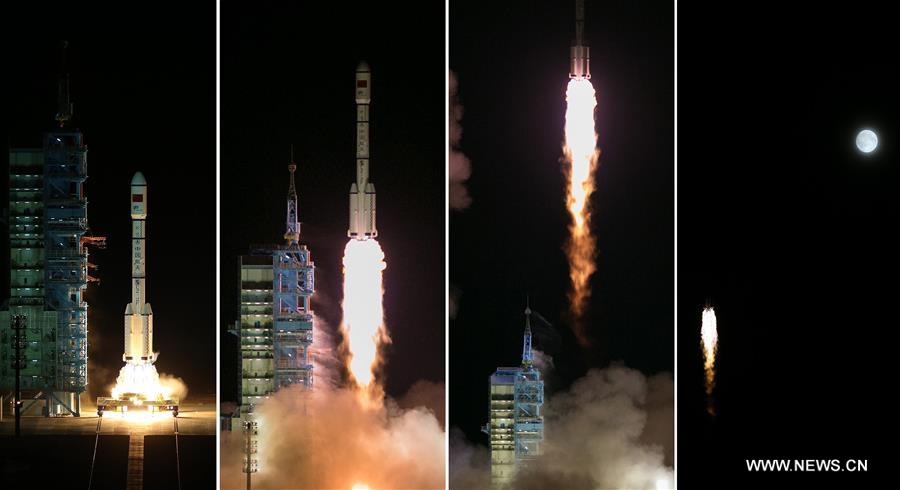
The combined photo taken on Sept. 15, 2016 shows China's space lab Tiangong-2 roaring into the air on the back of a Long March-2F rocket from the Jiuquan Satellite Launch Center in northwest China. (Xinhua/Ju Zhenhua)
JIUQUAN, Sept. 15 (Xinhua) -- China on Thursday launched space lab Tiangong-2 into space, paving the way for a permanent space station the country plans to build around 2022.
In a cloud of brown smoke, Tiangong-2 roared into the air underneath a mid-autumn full moon from the Jiuquan Satellite Launch Center on the back of a Long March-2F rocket, trailing a vast volume of flame.
Once in space, the 8.6-tonne Tiangong-2 will maneuver itself into an orbit about 380 kilometers above Earth for initial on-orbit tests, Wu Ping, deputy director of China's manned space engineering office, said on Wednesday.
The space lab will then transfer to a slightly higher orbit at about 393 kilometers above Earth, a height at which the future Chinese space station will be operating, before the Shenzhou-11 manned spaceship ferries two male astronauts into space to dock with the lab. The two astronauts will work in the lab for 30 days, before reentering Earth's atmosphere.
In April 2017, China's first cargo ship Tianzhou-1, which literally means "heavenly vessel," will also be sent into orbit to dock with the space lab and provide it with fuel and other supplies.
Wu said experts will verify and evaluate key technologies involved in on-orbit propellant resupply and equipment repairing, as well as those related to astronauts' long-term stay in space in the mission process.
They will also use the lab, which is designed to operate for at least two years, to conduct space science experiments on a relatively large scale compared with China's previous efforts.
China's manned space program has now entered a "new phase of application and development," Wu said.
Related:
Tiangong-2 takes China one step closer to space station
JIUQUAN, Sept. 15 (Xinhua) -- China's Tiangong-2 space lab blasted off on Thursday, marking another milestone in its increasingly ambitious space program, which envisions a mission to Mars by the end of this decade and its own space station by around 2020.
In a cloud of smoke underneath a mid-autumn full moon, Tiangong-2 roared into the air at the Jiuquan Satellite Launch Center in northwest China's Gobi desert, on the back of a Long March-2F T2 rocket at 10:04 p.m. Beijing Time. Full story
China acquires basic technology for manned lunar missions: chief engineer
JIUQUAN, Sept. 15 (Xinhua) -- China has acquired the basic technology to carry out manned lunar missions, chief engineer of China's manned space program Zhou Jianping said Thursday.
Compared with current missions, the technology used for manned lunar missions are more complex, Zhou said. Full story
China Exclusive: China to begin building space station in 2017: chief engineer
JIUQUAN, Sept. 15 (Xinhua) -- China will begin building a space station that is more economically efficient and uses more data than the current International Space Station (ISS), starting as early as 2017, chief engineer of China's manned space program Zhou Jianping told Xinhua Thursday.
"Once the space lab mission comes to an end, China will start building our own space station," he said, adding that China will launch a core module of the space station around 2018. Full story
Tiangong-2 "another significant step" for building China's space station: U.S. experts
WASHINGTON, Sept. 15 (Xinhua) -- China on Thursday took "another significant step" towards building a manned space station around 2020 with the successful launch of its second experimental space laboratory, U.S. space experts said.
"The launch of Tiangong-2 demonstrates China remains committed to human spaceflight and to the goal of building a space station in low earth orbit," Gregory Kulacki, senior analyst and China project manager at the U.S.-based Union of Concerned Scientists' Global Security Program, told Xinhua. Full story



